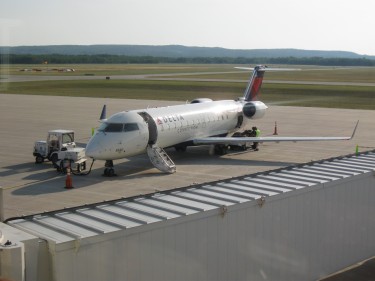We should all sign this petition for accessible airlines
by Ben
 By now you may have heard of D’Arcee Neal, a disability advocate who has cerebral palsy. He made headlines after dragging himself out of his seat on a United Airlines flight and crawling roughly 50 feet to his wheelchair so he could get to a restroom.
By now you may have heard of D’Arcee Neal, a disability advocate who has cerebral palsy. He made headlines after dragging himself out of his seat on a United Airlines flight and crawling roughly 50 feet to his wheelchair so he could get to a restroom.
Crawling? Could it be that urgent? A story in the Washington Post explains that D’ Arcee had just flown five hours without a bathroom break. Why wait? Because having a physical disability, with the necessity of a wheelchair for mobility, he could not physically make it to the rear of the plane where the restrooms are located. The aisles aren’t wide enough. From the Washington Post article:
Then he had waited the usual 15 minutes for the plane to empty before someone could help him exit in a special narrowly built wheelchair. But the wheelchair never came.
So D’Arcee waited.
And waited.
And waited.
Until finally, he could wait no longer.
The story reported that United Airlines sent a statement to CNN apologizing for the incident. “As customers began to exit the aircraft, we made a mistake and told the agent with the aisle chair that it was no longer needed, and it was removed from the area,” the airline said. “When we realized our error — that Mr. Neal was onboard and needed the aisle chair — we arranged to have it brought back, but it arrived too late.”
So yes, it may sound strange that a man would have to crawl the length of a plane to use the restroom, but this is no exaggeration. D’Arcee Neal crawled from his seat in 11F to the jetway, found his wheelchair waiting there, got in and rolled from there to an accessible bathroom in the airport.
For people with disabilities, this is a reality. A dangerous reality. Those in wheelchairs who choose to fly must take the risk of being trapped in the airline seat with nowhere to go, no way to get to the restroom, and no way to exit the plane in an emergency in a timely fashion.
Wheelchair users have to be transferred to a special airline chair to board a flight, but even if we were in our own chairs during flights, the aisles are not wide enough to access the restrooms.
I know it sounds crazy, but those of us who use wheelchairs face extra health risks to fly for business, on vacation, to see a ballgame, visit family, or just simply have the urge to fly. After boarding the plane, our wheelchairs (our mode of transportation, and the device that allows us to move 6 inches, 5 feet or 10 miles) are taken away and stored underneath the plane and left to roll around with boxes and suitcases. Essentially, our legs are gone, and they won’t return until we reach our destination.
I would like to believe in this day and age that wheelchair users could board a plane without having to be separated from our “legs.” Unfortunately, the airlines continue to operate as an old-fashioned, inaccessible entity. Yes, they follow the rules and guidelines of the Air Carrier Access Act (written in 1986, predating the ADA) but it’s obviously not sufficient.
If the airlines were truly accessible for people with disabilities (the largest minority in the world), do you think we would be reading these horrifying stories in the Washington Post and all sorts of other media outlets? I think not.
It’s time that legislators, airline executives, aeronautical engineers and thousands of individuals with disabilities get on the same page and start creating planes that are accessible to all.
No more days where a man like D’Arcee Neal has to crawl to relieve himself. No more days filled with fear of showing up at a destination to discover your wheelchair has been lost or broken. No more embarrassment, humiliation or feeling of helplessness without our chairs. These days must come to an end
 Let’s promote a life-changing improvement to the current system of airline transportation. If you believe airlines should be accessible to all, please sign this MoveOn petition for wheelchair access on commercial airlines. Let’s join together and acknowledge that it’s time for a change.
Let’s promote a life-changing improvement to the current system of airline transportation. If you believe airlines should be accessible to all, please sign this MoveOn petition for wheelchair access on commercial airlines. Let’s join together and acknowledge that it’s time for a change.
Related Resources:
Help advocate for people with disabilities in Washington, D.C., but joining Easter Seals Legislative Action Network.






